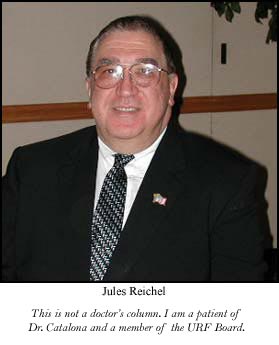NCCN Guidelines for Early Detection
 NCCN Guidelines For Early Detection
NCCN Guidelines For Early Detection
My favorite Practice Guidelines for the treatment of prostate cancer (CaP) are prepared by the National Comprehensive Cancer Network (NCCN) group of medical centers, which are the 19 comprehensive centers of excellence for practice and research on cancer in the US.
Northwestern University is one of the 19. Dr. Catalona is a member of the panel on early detection of CaP, and his work is frequently cited. Here are a few items from the 2004 guidelines:
Begin Screening
Screening should begin at age 40 to set baseline values. If the PSA is less than 0.6ng/ml then the next screening should occur at age 45.
If the PSA is equal to or greater than 0.6ng/ml, then annual screening with DRE (digital rectal examination) and PSA tests are advised.
Strong family history affects the risk of disease and the age to begin screening. The closer the relatives, the higher the risk.
PSA Velocity
If the PSA is above 2.5ng/ml but less than 10ng/ml, then the rate of increase of PSA over an interval of at least 18 months should be checked.
This rate of increase in PSA is called PSA velocity.
If the PSA velocity is equal to or greater than 0.75ng/ml per year, the suspicion of prostate cancer calls for a biopsy. If PSA is greater than 10ng/ml, a biopsy is always ordered.
Screening Thresholds
The PSA screening threshold for more specific testing is 2.6ng/ml.
In the PSA range from 2.6 to 4ng/ml, 22% to 25% of men have CaP. If the PSA is in this range, then the DRE and PSA velocity must be considered.
If the DRE is negative, then a PSA velocity less then 0.75ng/ml per year indicates the need for continued follow-up. If it exceeds this rate of increase, then a biopsy is the next likely step.
Alternative Tests
Percent-free PSA tests (free PSA divided by total PSA) are now approved for use when other tests results are uncertain.
The use of PSA density (PSA divided by prostate volume) was rejected as being too inaccurate.
Biopsy
10-core and 12-core biopsies are recommended, as is local anesthesia to decrease pain/discomfort. The number of biopsy cores remains in dispute with some centers using many more cores to reduce the risk of repeated biopsy.
New and Interesting
This important NCCN panel used studies and their clinical experience to justify: screening beginning at age 40, the use of PSA velocity as a critical evaluation value, the use of 10 and 12 core biopsies as preferable to the long-standing use of the six-core (sextant) plan, and the increased emphasis on heredity as a marker for potential disease.
The benefit of watching PSA over time rather than just PSA value by itself, has become a standard.
Dr. Catalona will shortly report important results on this topic. PSA velocity and doubling time are now viewed as critical measures of: disease aggressiveness, likelihood of death from CaP, and effectiveness of treatments such as hormonal therapy.
Early Detection Controversy
Controversy over these guidelines usually concerns Dr. Catalonas recommendation of a screening threshold of 2.6ng/ml, which the panel now accepts.
The primary question is whether a man can wait a little longer before taking action.
One study (Crawford 2002) shows that such delay is seldom justified since 83% of men who had PSA readings 3 to 4ng/ml, will be over the old screening threshold of 4ng/ml within 5 years, and a study by Dr. Catalona shows that the longer one allows the tumor to grow, the higher the probability will be of recurrence after surgery.
Early action is not only a great idea; its the only current strategy that reliably provides a likely path for the patient to continue on with his life largely as before.
The long list of famous CaP patients, gives strong subjective evidence that life largely as before can and does happen. Early detection and treatment by the best doctors can greatly lower the rates of suffering and death.
Change brings criticism and questions. The ones heard most often regarding early detection are: poor diagnostic practices can lead to overtreatment; patients often die from something else before they have severe prostate cancer; and formal scientific proof of this earlier approach to total treatment does not yet exist.
I could refute each of these criticisms many times over, but the ultimate point for patients like me is that men are returning to full lives after treatment, suffering and death are being reduced, and continuous and orderly improvement in medical treatment is occurring.
Good Outcomes
In the last issue of Quest, I provided some evidence of the benefit of this early detection approach. By combining results published by Drs. Walsh and Catalona, I showed why it is likely that for over 90% of Dr. Catalonas patients, such early detection and treatment should provide a 96% probability of cure (10-year non-recurrence).
Recent data also suggests that in the event of recurrence, salvage radiation may result in having 3/4 of the patients return to full remission for at least five years.
These results are for patients who began radiation when follow-up testing shows PSA levels 0.3 tp 0.6 and when high enough radiation dosage is used (possibly 6500cGy pronounced centi-Gray).
Treatment at this early time is critical to the success of salvage radiation. After surgery, its crucial for patients to take follow-up PSA tests on a regular schedule of 3, 6, or 12 months, as appropriate for their situation and time since surgery, to insure that the opportunity for treatment at these low PSA values is not missed.
Successful use of salvage radiation is fairly new and much dispute exists over which treatment is best for each patient, when it is best to begin, and how effective each treatment is. Nevertheless, a growing consensus suggests that an excellent second bite at the apple of success is becoming possible. However, failure to take follow-up treatment. if there is recurrence, will result in 2/3 of the patients having metastatic (spread) disease within 10 years.
Reducing Side Effects of ED and Incontinence
Several recent studies showed that nightly over many months (for up to 1 year) produced much superior sexual performance compared to higher dose use on-demand, and surprisingly seemed to prevent recurrence of the ED when therapy was stopped. Other studies showed a higher preference by men for Cialis and Levitra than for Viagra, but each patient had his own preference.
Dr. Catalona views the studies as correct, but says that the same result can be obtained with nightly stimulation of the penis in various ways, either with one method at a time or in combination. Frequent stimulation has been his recommendation to his patients.
Dr. Catalona has reported that about 4 to 5% of his patients have some level of urinary incontinence. When the incontinence is severe, Dr. Catalona recommends a surgically implanted sphincter to fix the problem.
Also, a device called a male sling is a potential help for this problem. The sling is inserted surgically during an operation that takes about an hour, and is often done on an outpatient basis. Recent results show about 91% of patients treated for incontinence with this surgery had excellent or good outcomes with few complications.
Patients Job
We patients with prostate cancer now have detection and treatment options that can let us live longer and live better. Our responsibility is to know that they exist and seek their benefit.
Feedback
Feedback is encouraged. Contact Dr. Catalona at his Website: www.drcatalona.com or send me an e-mail at jules105@aol.com. To see my prior articles, go to the Website and click on Quest Articles. Then scan down and click below my picture.
Click here to read the next article, A New Treatment Era: Better Outcomes for Prostate Cancer, in the One Man to Another series from Jules Reichel.











